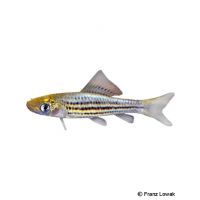Borneo Bonylipped Barb (Osteochilus pentalineatus)
| Borneo Bonylipped Barb Osteochilus pentalineatus | |
|---|---|
| Name | Borneo Bonylipped Barb |
| Name Lat. | Osteochilus pentalineatus |
| Family | Carps |
| Family lat. | Cyprinidae |
| Order | Carps |
| Order lat. | Cypriniformes |
| Origin | Borneo |
| Habitat | Streams, ponds |
| Diet | Omnivore |
| pH | 6.0-7.0 |
| Behavior | Peaceful |
| Keeping | Group, school |
| Care Level | Easy |
| Reproduction | Egg scatterer |
| Breeding | None reported |
| Life Span | N/A |
| Protection | No |
| Metric Units | |
| Size | 5 cm |
| Temperature | 22-26 °C |
| Hardness | < 10 °dH |
| Aquarium | ~ 100 l |
| US Units | |
| Size | 2" |
| Temperature | 72-79 °F |
| Hardness | < 178 ppm |
| Aquarium | ~ 25 gal |
Distribution and habitat
Borneo bonylip barbels are common in southern Borneo. They live in tributaries, streams, lakes and residual ponds with root, sand and gravel covered bottoms and dense riparian vegetation.
Maintenance
The aquarium should have a dense border planting, with many hiding and retreat possibilities (roots, stones) and offer sufficient swimming space. With shaded light (floating plant cover) and a dark substrate covered with some foliage (e.g. sea almond leaves) they show the most beautiful coloration.
No ammonia, ammonium and nitrite should be detectable in the water, the nitrate value should not exceed 100 mg/l. To ensure the water quality and oxygen content, a filter and heater adapted to the aquarium size is required, as well as lighting for the species-appropriate day-night rhythm of the animals.
Diet
In the wild they feed on worms, insect larvae, small crustaceans and detritus. The food supply consists of live, frozen and dry food. For a balanced diet, feed them once a day with a high-quality dry food (flakes, granules, pellets) as well as daphnia, moina, artemia, mosquito larvae, etc. (live or frozen). In addition, they need regular vegetable food, such as algae leaves, algae wavers or dry food with high vegetable content (spirulina, kelp)
It is recommended to feed small portions several times a day, which are eaten within a few minutes. A regular and varied diet promotes health and increases resistance.
Behaviour and compatibility
They are lively, peaceful schooling fish that can be kept well in a community aquarium with other peaceful fish. A group of at least 5-10 animals should be kept together.
Basically, only compatible fish species with similar demands on water conditions and water temperature should be socialized.
Sex dimorphism
Males are more intensely colored, slimmer and smaller than females.
Reproduction and breeding
They are free spawners that do not practice brood care. There are no known reports of successful breeding in the aquarium.
Important
The foliage (sea almond tree, oak, etc.) enriches the water with humic substances, naturally lowers the pH and, when rotting, promotes the development of microorganisms, which are a valuable secondary food source
The well-being of the fish should be monitored regularly. Temperature should be checked daily, pH, hardness and nitrate levels should be checked at least every 14 days. Regular partial water changes are recommended, even when contaminant levels have not yet reached the upper limit. Sudden changes in water quality should be avoided. Newly introduced fish must be accustomed slowly to the water in the aquarium.
Further literature can be found in your pet store.
References
Text: petdata; Image: Franz Lowak
Source: BMELV (1998): Tierschutzgutachten - Haltung von Zierfischen (Süßwasser); RIEHL & BAENSCH (2006): Aquarien Atlas Bd. 1, Mergus Verlag; ENGELMANN (2005): Zootierhaltung - Tiere in menschlicher Obhut: Fische, Verlag Harri Deutsch
- Gemäß § 21 Abs. 5 Tierschutzgesetz idgF
